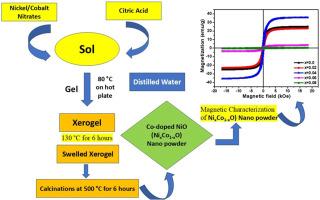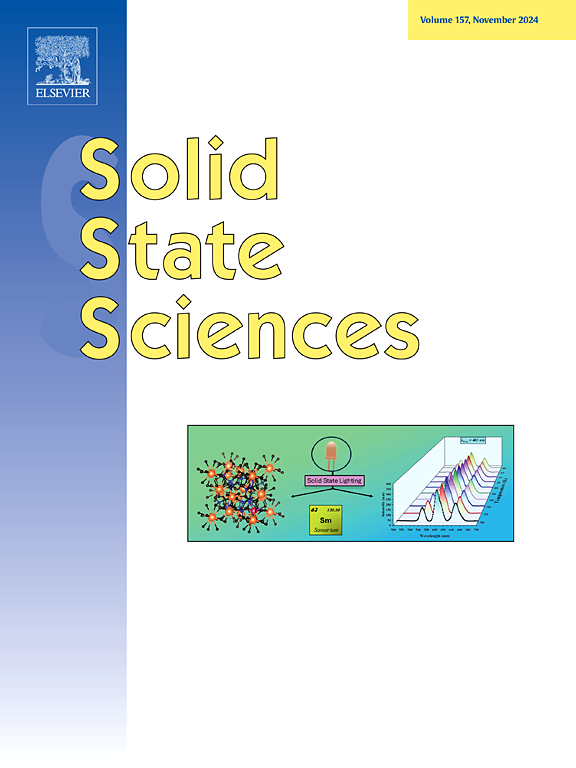Engineering magnetic phase transitions and bandgap tunability in Co-doped NiO nanoparticles for spintronic and optoelectronic applications
IF 3.3
3区 化学
Q2 CHEMISTRY, INORGANIC & NUCLEAR
引用次数: 0
Abstract
This study presents a comprehensive investigation of the structural, optical, and magnetic properties of cobalt-doped nickel oxide (Ni1-xCoxO, 0.0 ≤ x ≤ 0.08) nanoparticles synthesized via a citrate-assisted sol-gel method. X-ray diffraction (XRD) combined with Rietveld refinement reveals a doping-induced phase evolution from a mixed-phase system (NiO and metallic Ni) to a single-phase cubic NiO structure at x = 0.08. Raman and FTIR analyses confirm the incorporation of Co into the NiO lattice, along with strain-induced structural distortions and lattice disorder. Magnetic measurements demonstrate a distinct transition from ferromagnetic (FM) behaviour at x = 0.04 to antiferromagnetic (AFM) ordering at x = 0.08, attributed to Co-mediated exchange interactions and strain-induced modulation of spin correlations. Optical absorption spectra show bandgap tuning in the range of 2.9–3.5 eV, driven by defect-induced states at low Co content and quantum confinement at higher doping levels. These results highlight the crucial role of Co doping in simultaneously tailoring the structural, magnetic, and optical properties of NiO nanoparticles, establishing their potential for multifunctional applications in spintronic, optoelectronic, and photovoltaic devices.

用于自旋电子和光电子应用的共掺杂NiO纳米颗粒的工程磁相变和带隙可调性
本文研究了柠檬酸盐辅助溶胶-凝胶法制备的钴掺杂氧化镍纳米颗粒(Ni1-xCoxO, 0.0≤x≤0.08)的结构、光学和磁性能。x射线衍射(XRD)结合Rietveld细化表明,在x = 0.08时,掺杂诱导的相演变从混合相体系(NiO和金属Ni)到单相立方NiO结构。拉曼和红外光谱分析证实了Co与NiO晶格的结合,以及应变引起的结构扭曲和晶格无序。磁测量表明,由于共介导的交换相互作用和应变诱导的自旋相关调制,从x = 0.04时的铁磁(FM)行为明显转变为x = 0.08时的反铁磁(AFM)有序。光吸收光谱显示在2.9 ~ 3.5 eV范围内的带隙调谐,这是由低Co含量的缺陷诱导态和高掺杂水平的量子约束驱动的。这些结果强调了Co掺杂在同时调整NiO纳米颗粒的结构、磁性和光学性质方面的关键作用,并确立了其在自旋电子、光电和光伏器件中的多功能应用潜力。
本文章由计算机程序翻译,如有差异,请以英文原文为准。
求助全文
约1分钟内获得全文
求助全文
来源期刊

Solid State Sciences
化学-无机化学与核化学
CiteScore
6.60
自引率
2.90%
发文量
214
审稿时长
27 days
期刊介绍:
Solid State Sciences is the journal for researchers from the broad solid state chemistry and physics community. It publishes key articles on all aspects of solid state synthesis, structure-property relationships, theory and functionalities, in relation with experiments.
Key topics for stand-alone papers and special issues:
-Novel ways of synthesis, inorganic functional materials, including porous and glassy materials, hybrid organic-inorganic compounds and nanomaterials
-Physical properties, emphasizing but not limited to the electrical, magnetical and optical features
-Materials related to information technology and energy and environmental sciences.
The journal publishes feature articles from experts in the field upon invitation.
Solid State Sciences - your gateway to energy-related materials.
 求助内容:
求助内容: 应助结果提醒方式:
应助结果提醒方式:


